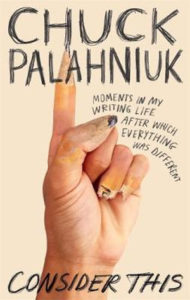Photo credit: Adam Levey
The cult favourite author shares some tips, spills some secrets and maybe even inspires a little. There are no rules around this club.
It’s often hard to take self-help books on writing seriously. If the writer hasn’t published a bestseller, one might think they lack credibility. If they deliver the same content after a string of hits, it’s possible you’ll find yourself yelling “Stop preaching at me from your ivory tower, buddy!” Hell, my own attempts at the subject have always felt a little self-serving.
Which is what makes Chuck Palahniuk’s CONSIDER THIS: MOMENTS IN MY WRITING LIFE AFTER WHICH EVERYTHING WAS DIFFERENT so refreshing. Like the much lauded On Writing from Stephen King, it’s a blend of memoir and writing advice. Palahniuk begins many of his sections with “If I was your teacher…” to create a kitchen table environment, where we sit with our imagined classmates gleaning tips and anecdotes from the guru.
This isn’t Palahniuk’s first stab at non-fiction, with his various essays and observations collected in volumes like Fugitives and Refugees and Stranger Than Fiction. Here he takes a different approach, fully aware that the conventions of the ‘how to’ guide are at odds with his edge lord persona. After all, what is Fight Club if not an indictment of guru culture.
Structured around a series of ‘Postcards’ and stories, there was a moment at the start where I was worried that this was going to be a tome full of name-dropping from that aforementioned tower. After all, I rarely get hooked on stories when the first cited source is Brett Easton Ellis. Yet these all serve to paint Palahniuk’s broader point: some of the most interesting places to start writing are those moments after the interesting peaks and troughs. As the title plainly states, Palahniuk wants you to consider those moments after some irrevocable change.
Which is why so many writing guidebooks fail, because once you’ve crossed the proverbial threshold it’s difficult to look back with the old lens. Palahniuk’s anecdotes attempt to explain how he got to a certain line of thinking without being too didactic. He actively encourages people to follow his lessons strictly, hammering home the idea of the literary striptease, at least until the point where you abandon can confidently them. For a writer who is often painted as an agent of chaos, this is reminder of the actual work behind that kind of oeuvre.
So, it’s unsurprisingly literate as well, drawing on books, short stories, films and comics he’s read or enjoyed over the years. Palahniuk draws on several of his own works as examples as well, although some get trotted out more than others. “Guts” – which is arguably Palahniuk’s most notorious short story, and later appeared in Haunted – is mentioned at least a half-dozen times, albeit in different contexts. That said, entire writing classes could be structured (and probably have been) around this 2003 story, an exemplar of how he often takes us to the edge before pushing us over at our own request.
Fans will also turn up for his stories about practicalities of road, including a series of alternatively hilarious and heartbreaking stories of fan and celebrity encounters. If you’ve read interviews with him, or been to one of his signings, you may recognise a few of these, or perhaps even make a cameo somewhere in here. You may not even believe all of the stories, despite Palahniuk’s insistence they are entirely true. (One story about a Parisian adventure with ‘heroin dealers’ is particularly memorable).
The net effect is de-romanticizing the life while doing what Palahniuk is preaching from the start: keeping the reader engaged. Honest, polished, and a treat for fans, even if you find some of the tips a bit too ‘Writing 101’ for your tastes, it might still inspire you to return to (or get cracking on) your next project.
2020 | US | WRITER: Chuck Palahniuk | PUBLISHER: Hachette Australia| LENGTH: 288 pages | RELEASE DATE: 14 January 2020





